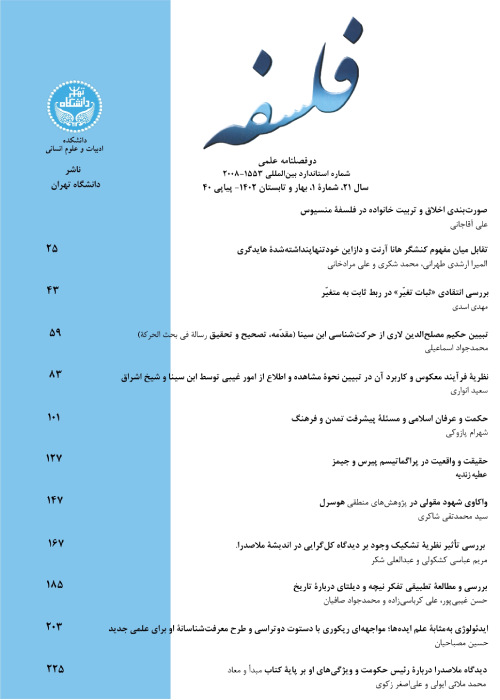The Composition of Matter and Form According to the Peripatetic
Author(s):
Article Type:
Research/Original Article (دارای رتبه معتبر)
Abstract:
It is widely known contrary to the Hikmat-Mota'aliyya, which believes in composition through unification of matter and form, the peripatetic believes in composition through annexation of the two. The attribution of this opinion to the Peripatetics is so strong that no one doubts that they believe in annexation composition, despite research on the subject demonstrating that it is not so simple and that such an attribution cannot be attributed to the Peripatetic with such conviction and certainty. The goal of this article is to refute the assertation that attributed to the peripatetic.Those who believe in union or annexation composition have provided arguments to prove their position. Seyyed Sadr al-Din Dashtaki, also known as Seyyed Sanad, was the first to consider the combination of matter and form to be a union, and Mulla Sadra agreed with him. They document their opinion on previous philosophers in the same way that those who believe in annexation composition do. Seyyed Sanad, the innovator of the unified composition, also considers his theory to be based on the opinions of Ibn Sina and Bahmanyar and cites evidence from them to prove that matter and form exist outside as a one entity, he used Ibn Sina's statement that matter and form are one according to the entity and multiple according to the meaning. Furthermore, the combination of soul and body, which represent matter and form, is annexed, according to Bahmanyar's statement.While rejecting Sadr al-Din Dashtaki, Fayyaz Lahiji, who some consider to be an Ibn Sina follower, believes that matter and form exist as two distinct entities, and most philosophers believe in annexation combination. The majority of philosophers who mentioned meant peripatetics, because the majority of those at the time were peripatetic. Contemporaries of Fayyaz Lahiji, Mirdamad and his student Seyyed Ahmad Alavi, also consider the combination of matter and form to be annexed, rather than the union combination in the mind, such as genus and differentia. Hakim Sabzevari, a admirer of Hikmat-Mota'aliayya and an interpreter of Mulla Sadr's works, disagrees with him on this point accepting annexation composition as the opinion of great philosophers, including Ibn Sina. As a result, The issue of composition by way of unification and composition by way of annexation is one of Sadr al-Din Dashtaki's innovations in the ninth century AH and has not been discussed previously. As a result, it was not discussed in the books of Ibn Sina, Farabi, Bahmanyar, and other Peripatetics prior to Dashtaki, and they did not discuss this issue, but during and after Sadr al-Din Dashtaki, many philosophers, mostly Peripatetics like Mirdamad and Fayyaz Lahiji, argued against Dashtaki on this point. If we present this issue to the Peripatetics before Dashtaki, we can find evidence in favor of both unification and annexation, so one of these two cannot be attributed to them, and only through tolerance can the Peripatetics be convinced of the annexation combination.
Keywords:
Language:
Persian
Published:
Philosophy, Volume:50 Issue: 2, 2023
Pages:
159 to 172
magiran.com/p2535506
دانلود و مطالعه متن این مقاله با یکی از روشهای زیر امکان پذیر است:
اشتراک شخصی
با عضویت و پرداخت آنلاین حق اشتراک یکساله به مبلغ 1,390,000ريال میتوانید 70 عنوان مطلب دانلود کنید!
اشتراک سازمانی
به کتابخانه دانشگاه یا محل کار خود پیشنهاد کنید تا اشتراک سازمانی این پایگاه را برای دسترسی نامحدود همه کاربران به متن مطالب تهیه نمایند!
توجه!
- حق عضویت دریافتی صرف حمایت از نشریات عضو و نگهداری، تکمیل و توسعه مگیران میشود.
- پرداخت حق اشتراک و دانلود مقالات اجازه بازنشر آن در سایر رسانههای چاپی و دیجیتال را به کاربر نمیدهد.
In order to view content subscription is required
Personal subscription
Subscribe magiran.com for 70 € euros via PayPal and download 70 articles during a year.
Organization subscription
Please contact us to subscribe your university or library for unlimited access!



